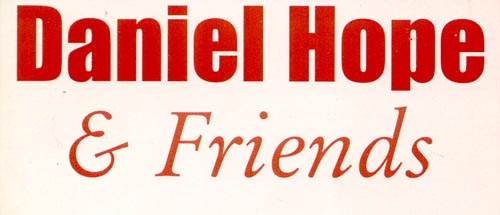
The setting was auspicious; the Steinway's lid thrust wide open (as Szymon Goldberg memorably insisted it should always be - at a Dartington Violin Master Class many years ago) and no music stand on the platform. Daniel Hope has been performing the Schnittke Sonata No 1 of 1963 in public since he was 15, and he later studied it in detail with the composer, as he tells us in an autobiographical note about his personal contacts with the ailing composer. It incorporates serialist techniques in a heady mix of styles characteristically juxtaposed. The largo pays direct homage to Shostakovich and is framed by a hectic scherzo and a spoof finale, which parodies the popular song La Cucaracha.
It was well matched in the first half by Shostakovich's late and only Violin Sonata Op 134, which also uses twelve-tone technique expressively rather than dogmatically. There is an emphasis on the 4th, an interval said to symbolise death for Russian composers, and its driving allegretto is a fierce, unfunny scherzo with relentless repeated notes - 'like the firing of a Kalashnikov', it was suggested to us. The finale is a long set of 24 variations, two of them solo cadenzas for one then the other player. The end is despairing, with 'the 4th reaping its gruesome reward', says Hope.
These formidable sonatas, which Hope & Mulligan had previously recorded for Nimbus (NI 5631) made for a distinguished hour of music making by two well-attuned partners in perfect ensemble and accord.
For well earned relaxation (theirs and ours) they returned with the under-played Walton sonata from the late '40s, an entirely characteristic romantic piece spiced with just a little acerbity, and with all Walton's individual harmonic finger prints and a wayward darting, rhythmic inventiveness which can suggest improvisation. There are only two movements, the second another set of contrasting variations, and there is a certain leisureliness in their progress, leaving little change from half an hour, as with each of the Russian sonatas. This too has been recorded by Hope ad Mulligan, on Nimbus 5666. The programme was filled up (overfilled?) with Ravel's little Kaddish, arranged by Hope for unaccompanied violin, and (incongruously in this context) a group of Weill songs from The Threepenny Opera, arranged by Hope's pianist partner for a small chamber ensemble of four strings with piano. The wind-led pungency of the original was conspicuously absent, and the whole proved a poor reason to bring in baritone Benno Schollum and some excellent London free-lancers for that item alone.
Peter Grahame Woolf
 Return to:
Return to: